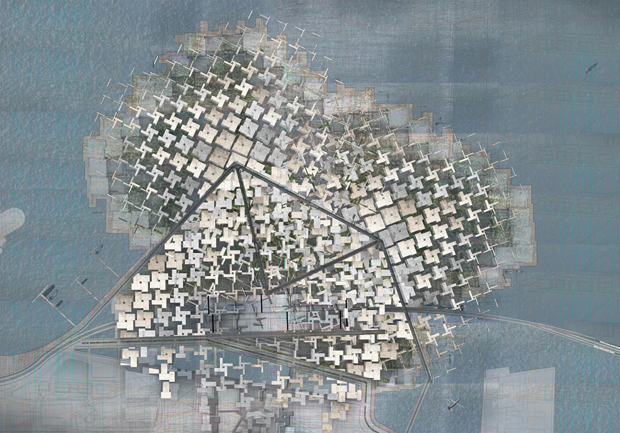Post-Traumatic Urbanism
Mumbai as a city has undergone several traumatic events in the past few years. Those in my direct memory and experience are the 26/11 attacks and the painfully recent 2011 bombings. Earlier I argued that despite these tragic events the city in essence remained the same. How does a city survive these traumatic events whether they are natural flash floods or terror attacks, and in what way does it change? Today people try to understand how cities survive and evolve through math and science. As a philosophy urbanism states that cities are vitally important to the progress of humanity. In his talk The Surprising Math of Cities and Corporations, West argues that cities are both the solution and the problem, underlining their bipolarity.
And the tsunami of problems that we feel we're facing in terms of sustainability questions, are actually a reflection of the exponential increase in urbanization across the planet... However, cities,despite having this negative aspect to them, are also the solution. Because cities are the vacuum cleaners and the magnets that have sucked up creative people, creating ideas, innovation, wealth and so on. So we have this kind of dual nature. (Geoffrey West, 2011)
West explains why cities are so successful when he says 'You could drop an atom bomb on a city, and 30 years later it's surviving. Very few cities fail.' Mumbai as a city has survived several traumatic events over the past two hundred years, though nothing on such a catastrophic level. It is an ancient place that has been ruled by a succession of invaders. There is even evidence that suggest that the islands have been colonized by humans since the Stone Age. Each event in this recorded and unrecorded past have changed the landscape and its people, but I am most interested in its recent traumas.
So cities are extremely successful, bipolar creatures. But how do traumas affect them? Philosopher and critical theorist Andrew Benjamin says that 'trauma involves a more complex sense of place.' He proposes that the city contains forgotten and repressed settings that are beyond memory but always present, creating an 'estrangement' and sense of the 'unaccustomed' when such events return.
The term 'post-traumatic' refers to the evidence of the aftermath - the remains of an event that are missing. The spaces around this blind spot record the impression of the event like a scar. (Lahoud, 2010. p.19).
Cities like Mumbai and Beirut have developed in unstable uncertainty and in many ways are resilient survivors. They have adapted with 'redundant networks' and 'diversity and distribution' rather than 'centralized efficiency' which makes them flexible in the face of shocks to infrastructure (Lahoud, 2010). When it comes to events like the most recent bomb attack in 2011, the city picked up the pieces and went on the next day as if nothing had happened. Local trains continued to run. The event was given its significant narrative by the media and the places that were bombed were cleared up. Memories and the gaps created by such violence will always remain an intrinsic part of the city's architecture. But it is Mumbai's impenetrable resilience in the face of such catastrophes that fascinates me. Events such as 9/11 in a first world country completely derailed the city, but in Mumbai it was in many ways business as usual. But forgetting like we do in Mumbai does not erase the hurt.
 The Diversity Machine and Resilient Network, 2009. Social Transformation Studio. Martin abbot, Georgia Abbot, Clare Johnston, Joshua Lynch and Alexandra Wright.
The Diversity Machine and Resilient Network, 2009. Social Transformation Studio. Martin abbot, Georgia Abbot, Clare Johnston, Joshua Lynch and Alexandra Wright.
Anthony Burke says that the reason cities are so difficult to predict is that they are very complex systems 'growing at the edge of chaos.' Even small events can lead to avalanche-like conditions because both natural and human-made catastrophes display a self-organizing criticality or the:
...tendency of large systems with many components to evolve into a poised, `critical' state, way out of balance, where minor disturbances may lead to events, called avalanches, of all sizes. Most of the changes take place through catastrophic events rather than by following a smooth gradual path. The evolution to this very delicate state occurs without design from any outside agent. The state is established solely because of the dynamical interactions among individual elements of the system: the critical state is self-organized. Self-organized criticality is so far the only known general mechanism to generate complexity. (Per Bak, 1997, p.1).
The idea that a city is on the verge of chaos is not far from many narratives in western popular culture. The accepted line is that just one push is enough to bring the whole system crumbling down. However the theory above is not as simple as that, these systems are large and therefore extremely difficult to destroy completely. Its heartening to see that even human cities are in the end, part of nature, and follow patterns similar to natural phenomenon such as weather.
Although there are no definitive answers to what post-traumatic urbanism is the term itself raises critical questions and discussion. An often quoted statistic today is that the urban world is larger than the rural world, which underlines the importance of trying to understand urban trauma and its effect on the city and its people. In my journey to capture the essence of Mumbai, to explore unexpressed feelings of conflict created by repressed events and resolve my own perceptions and experience; it is this complexity which is central to understanding my art.